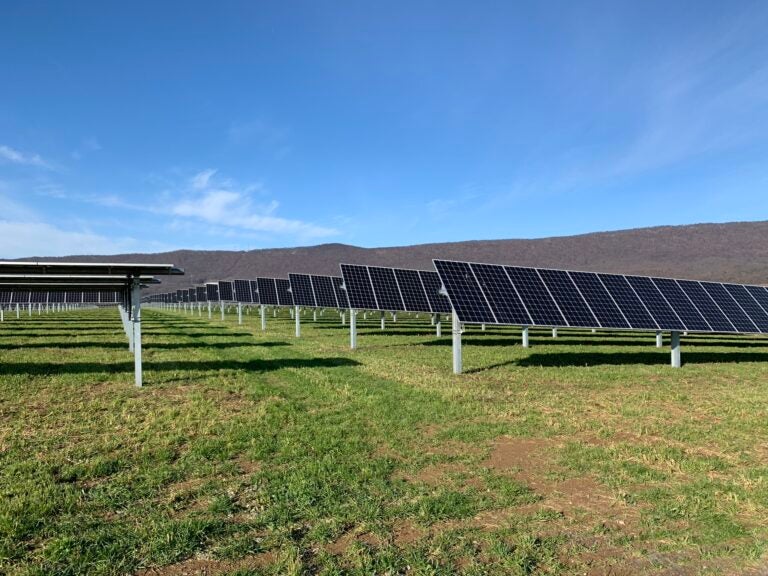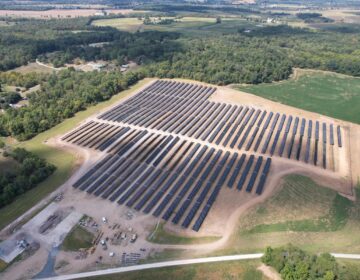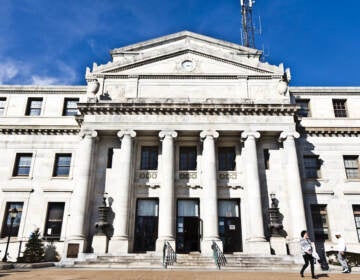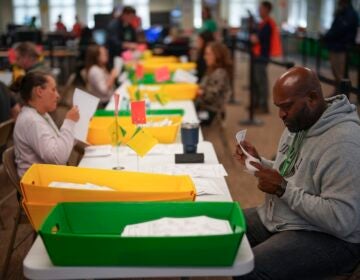Suburban Philadelphia counties join forces to purchase renewable energy
The Sustainable Energy Partnership of Southeastern Pennsylvania will set renewable energy guidelines in the coming months.

This solar field, built by Lightsource BP in Lurgan Township, Franklin County, provides power to Penn State. Panels are seen here on Nov. 24, 2020. (Rachel McDevitt/StateImpact Pennsylvania)
This story is part of the WHYY News Climate Desk, bringing you news and solutions for our changing region.
From the Poconos to the Jersey Shore to the mouth of the Delaware Bay, what do you want to know about climate change? What would you like us to cover? Get in touch.
Philadelphia’s four collar counties have joined forces to buy renewable energy to power its government buildings and operations.
The Sustainable Energy Partnership of Southeastern Pennsylvania (SEPSA), composed of Bucks, Chester, Delaware and Montgomery counties, awarded a five-year contract to WGL Energy to manage the purchase of renewable energy sources.
The combined purchasing power of the four counties — whose operations together use more than 89 million kilowatt hours of electricity annually — is also an advantage, officials said.
“This is going to give us a lot of flexibility to look at renewables,” said Dean Dortone, Montgomery County’s chief financial officer. Dortone said it is expanding its options, which could include developing a solar field or wind farm. A solar field in Adams County, developed by Philadelphia and recently hooked up to the grid helps provide about 30% renewable energy to municipal buildings.
SEPSA was established in 2020 so the counties could work together with the Delaware Valley Regional Planning Commission to purchase wholesale energy and access renewable energy options.
As of now, DVRPC has a goal of net-zero emissions by 2050. Counties are also exploring renewable energy sources close to home, with Montgomery County looking at a potential hydroelectric dam in Norristown as a way to reach net zero as quickly as possible.
“This is not just a local problem. In terms of climate, it’s a global issue,” said Montgomery County Commissioner Neil Makhija. “But to the extent that we haven’t had the robust (federal) policy that’s required, local governments, state governments have to be creative about the kinds of levers that we can pull to make a difference. And this is one of the ways that is, within our power, which is using literally our purchasing power.”
SEPSA will set renewable energy guidelines in the coming months; Montgomery County officials said that one of the goals will be to promote the expansion of renewable energy production in the region and throughout the state to also support job creation in Southeastern Pa.
In 2025, the first year of the contract, WGL Energy will start by purchasing conventional energy from PJM, which in 2022 consisted of 6.8% wind- and solar power combined. Going forward, SEPSA will need to find other renewable energy sources on the market or develop a source itself through a power purchase agreement similar to Philadelphia’s Adams County solar field.
Makhija said collaboration between the four counties on climate impact and adaptation issues could extend beyond SEPSA.
“We are in, in the face of the reality of climate change, taking action, doing everything we can, and this is one of the things that we’re able to take a step on, at least locally, as we advocate for other measures at the state and federal level,” he said.

Get daily updates from WHYY News!
WHYY is your source for fact-based, in-depth journalism and information. As a nonprofit organization, we rely on financial support from readers like you. Please give today.






